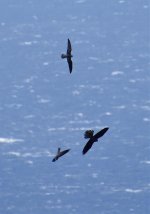Hi all,
Just wondering how often you guys/girls have observed attempts, by any kind of raptor, anywhere in the world, to capture hirundines and swifts - and how often do you think this group of birds are captured? From what I can gather, swifts in particular, seem to appear quite regularly in peregrine prey remains both in Europe and elsewhere, but I've hardly ever seen a serious attempt. Any accounts/anecdotes would be really interesting. I recall one of the birders who saw the Hebridean white-throated needletail mentioned a peregrine stooping unsuccessfully at it.
Cheers,
patudo
Just wondering how often you guys/girls have observed attempts, by any kind of raptor, anywhere in the world, to capture hirundines and swifts - and how often do you think this group of birds are captured? From what I can gather, swifts in particular, seem to appear quite regularly in peregrine prey remains both in Europe and elsewhere, but I've hardly ever seen a serious attempt. Any accounts/anecdotes would be really interesting. I recall one of the birders who saw the Hebridean white-throated needletail mentioned a peregrine stooping unsuccessfully at it.
Cheers,
patudo








